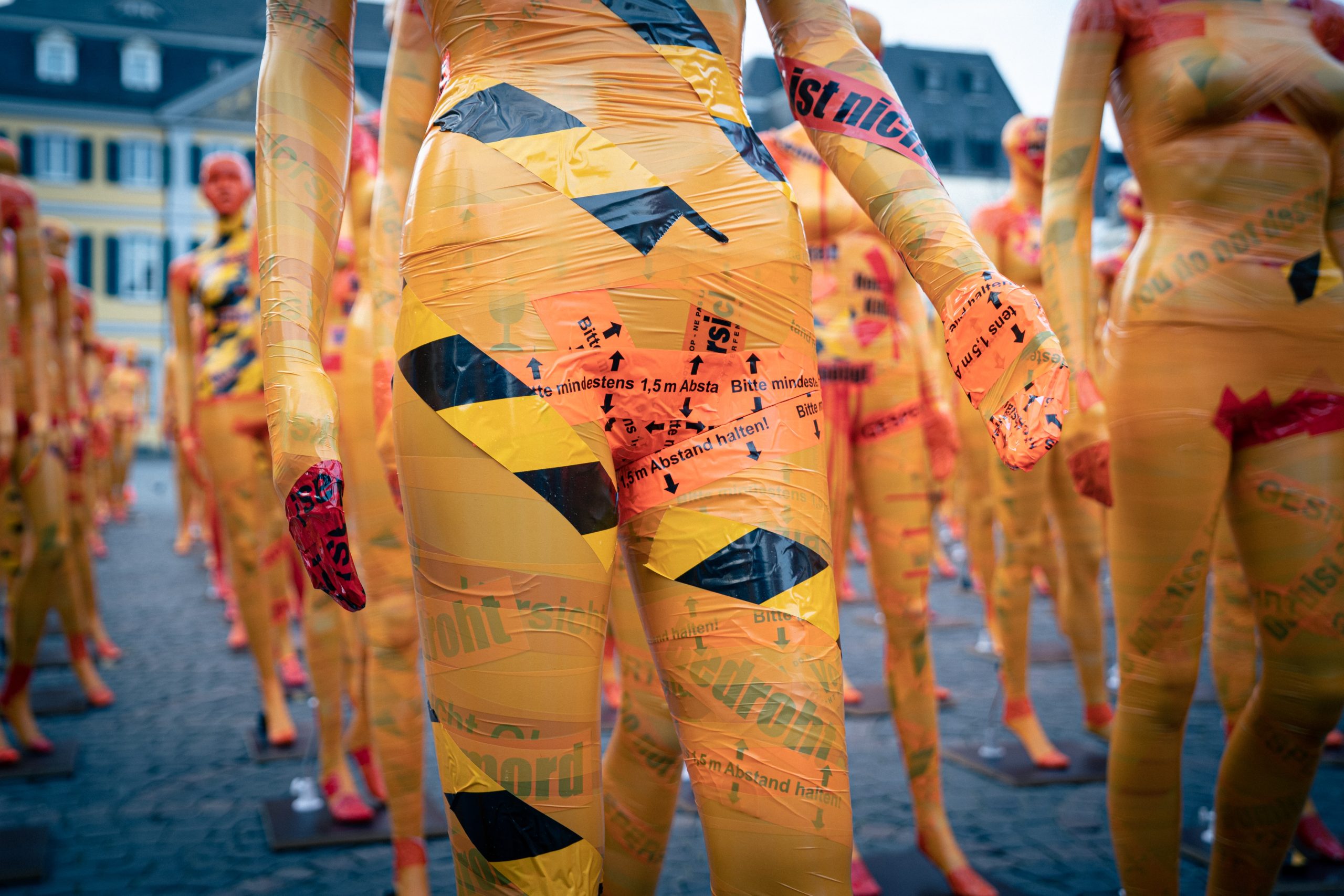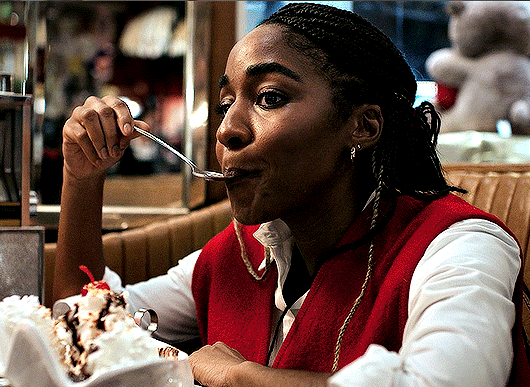Books & Culture
Malevolent Vulvas Collapse the Veil Between Worlds in “Stranger Things”
Myths about monstrous vaginas and the evils of female pleasure help maintain worldwide patriarchy

In the climax of Stranger Things 3 a giant laser punctures the wall of an underground bunker, breaching the veil between ours and the Upside Down. An alternative dimension which lies parallel to our own, the Upside Down is governed by an evil hive-mind intelligence known as the Mind Flayer. The fissure between worlds looks remarkably like a vulva.
I see vulvas like Cole sees dead people in The Sixth Sense: in rock faces, in clusters of petals, in art, in TV and film. My own predilection for vulvas, the fact that I have one, my training as a doula or my participation and facilitation of vulva ‘acceptance’ workshops are all factors that make me extra sensitive to images resembling conical folds of flesh—both in nature and in media. I spend a considerable amount of my time thinking about, talking about and writing about vulvas. I’ve been to vulva workshops, given vulva workshops and even named my vulva. I have vulva pins, vulva tote bags, vulva stickers on my computer. But my celebration of vulvas is not shared by everyone.
It would appear the Duffer Brothers, creators of the 1980s nostalgia-fueled, horror romp Stranger Things, are equally obsessed with vulvas. From the flower-like heads of Season 1’s Demogorgons, to the Mind Flayer’s clitoral hood-like head in Season 2, vulvic images linked to corruption, destruction and the end of days abound throughout the Stranger Things franchise. Season 4 promises to go even further. The cover image shows our heroes facing the bottom of a shaft where another tentacular fissure, resembling a molten version of the mythical vagina dentata, threatens to tear our world apart.
As the malevolence of the vulva imagery increases in intensity, the veil between ours and the Upside Down becomes ever thinner, heralding an evil so powerful it could bring about the end of days. The Duffer Brothers are not unique in their fear of vulvas. From Facehugger in Aliens, to Brain Bug in Starship Troopers and The Eye of Sauron in Lord of the Rings, vulva and vagina-like monsters proliferate in body-horror, sci-fi and fantasy, suggesting that they’re not only repulsive and fearful, but dangerous as well.
In this post-truth world, the specter of gender ideology, denounced from the Vatican to the White House, replaced the 1980’s Satanic Panic.
Stranger Things opens in 1983, smack in the middle of Ronald Reagan’s first term. His administration, the dominant political force throughout the 80s, has been credited with the return to conservatism and ‘family values’ and a virulent backlash to the flourishing of amoral liberalism following decades of feminist and LGBTQ+ activism. This coincided with, and was facilitated by, the rise of the Christian right as a political force in US politics and associated moral panic over satanist practices, child abuse and threats to the nuclear family. While a Season 2 teaser features ‘An American Heroes’ speech delivered by Reagan himself, the show ignores Reagan’s backlash against sexual rights and freedoms and his administration’s aggressions around other issues. Stranger Things first streamed on Netflix in 2016, in the thick of Trump’s openly misogynistic, anti-trans and white supremacist election campaign. As president, Trump persisted with the virulent Republican agenda, consistently attacking sexual and reproductive rights. In this post-truth world, the specter of gender ideology, denounced from the Vatican to the White House, replaced the 1980’s Satanic Panic.
The show’s action centers on the struggle between the US and Russians to control and weaponize the monstrous power of the Upside Down. The real horror of Stranger Things is, however, the war on sexual rights and freedom, spanning the last 40 years. This menace lurks behind the scenes, like the Mind Flayer’s poisonous vines which have colonized the town of Hawkins in the Upside Down, suffocating life and all potential for autonomous action. At the heart of this conservatism is a fear of bodies, their reproductive potential and the dangers of unrestrained sexuality and gender expression.
As a child of the ’80s, I too can delight in the bad-hair, shoulder-padded, walkie-talkie, power-ballad nostalgia of Stranger Things. A time before the internet and mobile phones, when we could fool ourselves into believing kids were free to roam around their small towns basking in suburban bliss with minimal parental supervision. Lost in the world of the show, I can forget how, in 1983, divorce was still illegal in my home country of Ireland. Or how contraception was only available to couples with a marriage license and two thirds of the population would soon vote to impose a constitutional ban on abortion under all circumstances.
Increasing contact with the outside world, particularly school, taught me that bodies were not an object for discussion, never mind celebration.
My young, militantly atheist parents worked hard to shield me from this reality while actively trying to break the culture of shame around bodies and sexuality. My brothers and I had access to picture books depicting ‘where babies come from’ and ‘what bodies are like’ from before we could read. No doubt both cis and hetero-normative in hindsight, these books had to be hidden from my grandparents whenever they visited. My favourite had a two page spread of vulva illustrations, explaining the different shapes and colours of vulvas. I remember standing naked in my bedroom, bending over and straining my neck to see between my legs in an attempt to cross reference my vulva with those in the book. I wanted to determine which kind I had. The results were inconclusive but it was enough to know there was as great a diversity of vulvas in the world as there were noses.
Such body positivity did not last long outside of the bubble of my immediate family. Increasing contact with the outside world, particularly school, taught me that bodies were not an object for discussion, never mind celebration. To the outside world, bodies, especially our between me-down there, were shrouded in secrecy, shame and fear.
Myths about the monstrous nature of vaginas and vulvas traverse millennia and human cultures. In Ireland, Sheela Na Gigs, a bald and wide-eyed creature displaying an oversized vulva can often be found carved into the stone above church doorways. Rather than a symbol of fertility, the Sheela’s vulvas were considered so terrifying they are thought to have been used to ward off evil spirits.
The myth of the toothed vagina (vagina dentata) has appeared in tales from Central America and Europe to Africa and Asia-Pacific. This devouring or castrating vagina is thought to symbolise the dangers of uncontrolled female sexuality and predation on masculinity and virility. The woman who bears a vagina dentata must be subdued by a male hero who removes the offending teeth.
But sometimes the vagina bites back. The 2007 cult horror-comedy Teeth, directed by Mitchell Lichtenstein, brought the vagina dentata into popular culture in a big way. Dawn, the protagonist, is a high school student and spokesperson for ‘The Promise’, a purity pledge organization in her hometown. When her fellow pledge-mate and would-be boyfriend Toby rapes her, Dawn’s body responds by severing his penis from his body. After experiencing a further succession of sexual aggressions, Dawn realizes her body has developed an adaptation: the growth of razor sharp teeth in her vagina.
While unconcerned about the normality of my vulva’s appearance, I was preoccupied about whether or not my vulva smelled and tasted normal.
As Dawn tentatively explores her own anatomy and seeks out information from text books where diagrams of the vulva, though not the penis, have been covered by large gold stickers, I remembered my own teenage explorations. By 15, my childish openness had been replaced by a cautious curiosity, and guilt I could not ascribe to any single source. When text book cross sections failed to explain just how exactly I was made ‘down there’ I realised mirrors might help me get a better view. I kept a tiny compact by my bed, and explored myself in the half-dark when everyone else in the house was asleep. Though generations of feminists had been practicing self-exploration as a political act, growing up in small town suburban sprawl not unlike Dawn’s home town, I believed self-exploration was not something I should do, nor tell anyone about.
By the time Teeth premiered in 2007, the Purity Pledge phenomenon was a mainstream rather than a fringe practice. At 22 my precious body positivity and teenage curiosity had been whittled down to a generalized shame and revulsion at my own vulva. While unconcerned about the normality of my vulva’s appearance, I was preoccupied about whether or not my vulva smelled and tasted normal. I worried these things would actively keep partners from directing their kisses between my legs. Waitressing part-time at a local pizzeria during college, I overheard a joke shared between the delivery drivers – all cis men – about how the popular seafood pizza left their cars smelling like a cheap brothel. I remember almost nothing about this job except that joke. The misogyny of their banter haunted me for years. Apart from the clear prejudice against sex-workers, the joke told me my body was not only foul smelling, but also an object of public ridicule.
Vulvas are fleshy, slippery, hairy, smelly, unruly things. They are often understood to have no real purpose other than marking the boundary between an outer world of smooth skin and an inner cavernous world of the vagina and uterus whose functions have long been the objects of fear, misunderstanding and control. The etymology of vulva derives from the Latin volva, literally meaning womb. Vulvas are often mistakenly called vaginas – coming from the Latin – literally meaning sheath or scabbard (for a sword-penis). From humanity’s earliest beginnings, the vulva has been rendered invisible, or of little significance outside of reproductive capacities, penetrative potential (ie the pleasure of men) or a signifier of evil, at least in the Western world. As late as the 1980s, with the US firmly in the grip of the Satanic panic, the vulvas of people suspected of occult activities were scrutinised in court proceedings which echoed medieval examinations to detect sin or witchcraft.
The whole premise of Season 3 sees the Russian army attempting to use a phallic laser to reopen this same fissure.
Evil manifests throughout Stranger Things as creatures bred from the toxic hive-mind of the Upside Down. The Mind Flayer’s offspring, the Demogorgons of Season 1 are equipped with bulbous heads that open like petals, revealing rows of deadly sharp teeth around a cavernous mouth, an echo of the toothed vagina. As the seasons progress the evil evolves. In Season 2 we see Eleven bursting through an oval-shaped bloody membrane—not unlike a hymen—to escape the horrors of the Upside Down and return to our own world. The Mind Flayer evolves into a giant spider like creature whose body resembles the internal structure of the clitoris and his head the clitoral hood. The Season 2 finale, in an episode called ‘The Gate’, tasks Eleven with sealing another vulva-like bloody and pulsating fissure between ours and the upside down world with the power of her mind. The whole premise of Season 3 sees the Russian army attempting to use a phallic laser to reopen this same fissure.
Even when the fissures have been resealed the Upside Down continues its corrupted mimicry of our world. The threat of another rupture, either provoked by the Mind Flayer itself or the US or Russian Military, is constant. If the rupture is left open our world will be consumed and rebirthed in the image of the Mind Flayer’s poisonous and corrupting evil.
The original breach between worlds was not of the Mind Flayer’s design, but an accident caused by a pre-pubescent girl, the victim of government experiments. It is never clear if those pushing Eleven to use her telekinetic powers understand the destruction they might unleash. All that stands in the way are a motley crew of teenagers, led by Mike, obsessed with Dungeons and Dragons D&D.
They exist in a childish fantasy world where their favorite pastime is spending their nights in a basement playing D&D. The fact that D&D became a target during the Satanic Panic as a game which encouraged witchcraft, demon worship and occult practices is mentioned throughout Season 4. Ironically, for Mike and his buddies, the D&D universe is all they have to name and understand the manifestations of evil emanating from the Upside Down.
As Dawn explores how her body responds to both aggression and pleasure, she uses her powers to protect herself from the sexual aggressors that surround her.
Living in the shadow of evil, Eleven and her friends carry on with normal life, even when their attempts are thwarted by the adults in their lives. Captain Hopper’s principal occupation throughout Season 3 is his urgency in keeping Eleven and Mike apart and ensuring they do not have the opportunity to engage in any sexual activity. He stands as both guardian and captor of Eleven, protecting her from the threat of further experimentation by the government while also denying her agency over her body, desires and sexual expression. Portrayed as a blundering and caring, albeit overbearing father, there is no substantive interrogation of his need to control his adopted daughter’s sexuality. His insistence that Eleven remain chaste, rather than engaging in healthy teenage exploration, is not out of place in an administration which supported the first federal abstinence-only education program in 1981 through the Adolescent Family Life Act. This trend has only deepened in the intervening years with federal funding for abstinence-only education increased from US$5 million in 2011 to US$35 million annually in 2021.
As each season of Stranger Things unfolds, the protagonists evolve from children into adolescents. Their growing awareness and explorations of their incipient sexual desires is mirrored in the Mind Flayer’s developing intelligence, determination and expanding powers of procreation and domination. Season 4 feels self-consciously aware of at least some of its gendered shortcomings and the Duffer Brothers appear to have tried to remedy at least some of these. We discover that Robin is openly queer, and possibly neurodivergent, with feelings for her bandmate Vicky. This, however, never materializes beyond a crush and Steve is the only character she has come out to. The show’s stars Millie Bobby Brown (Eleven) and Noah Schnapp (Will) have hinted at the possibility that Will is not straight. In a letter to Eleven, Hopper admits his overprotection of Eleven’s sexuality may have been misguided. Nevertheless, in a show which follows Eleven’s transition from child to teenager, learning to navigate the world outside her former prison of Hawkin’s Lab, there is a rotund silence around the physical and hormonal upheavals of puberty. And if queer storylines remain off-screen it feels like the Duffer Brothers’ are only paying lip service to diversity.
In contrast to the prohibitions imposed on Eleven, Dawn in Teeth choses chastity for herself. Even before she inadvertently begins castrating her sexual aggressors, she is aware of something different about her body. The promise to protect boys from the threat represented by her female sexuality, is in this case, grounded in real fear about the potentialities of her own body, rather than a parental imposition. Dawn eventually overcomes the terror caused by her monstrous vagina, and learns to harness this power, using it first for revenge and then turning the violence consciously against her aggressors. As Dawn explores how her body responds to both aggression and pleasure, she uses her powers to protect herself from the sexual aggressors that surround her including gynecologists, classmates and her step brother. In a similar twist, Zoe Benson from American Horror Story Coven, also learns to embrace the potential of her own mutation saying she ‘Might as well put this curse to some use.’ Dawn and Zoe are the antithesis to Hopper’s paternal impositions. The reality for most women is not about protecting the socially-constructed myth of virginity, but protecting their bodily integrity from the omni-present threat of male violence. In 2022 girls are regularly targeted, shamed and sent home from school for ‘immodest dress’ with justifications from teachers and school boards that their leggings, shorts or tank tops are distracting for their male peers. Dawn’s rebellion against this violence and the culture which would shame her is why Teeth became a cult feminist classic, perhaps as relevant today as it was in 2007.
Returning to the very beginning of Stranger Things, before we have had more than a glimpse of the horror manifesting below Hawkins, the Demogorgon’s second victim, Barb, disappears the same night her best friend Nancy loses her virginity to high school heartthrob, Steve. As we cut between Nancy’s desire, then pleasure, to horrific images of Barb being stalked by a Demogorgon in the Upside Down. Nancy is barely allowed one morning to bask in the post-coital glow before she realizes the consequences of insisting Barb accompany her to the party at Steve’s house. Nancy’s lust puts Barb in danger, the guilt of which will haunt her until Season 4. The implication is clear: teenage sex and death go hand-in-hand. In the Reagan era-Stranger Things universe, perhaps it is the world of unrestrained adolescent sexuality, particularly teenage girls who demonstrate agency over their own bodies and desires, that is the real threat. Female sexuality has the power to turn the world upside down and cause the collapse of everything we have ever taken for granted.
The other side of fear is ignorance, and when it comes to the vulva, the depths of misunderstanding are staggering. In A Whole Other Hole, a classic episode of Orange Is the New Black, Sophia—played by Laverne Cox—explains the anatomy of the vulva to a mystified crowd of cis women. The episode focuses on the difference between the ‘pee hole’ and the vagina, but Sofia also instructs her friends to go back to their bunks and get to know their own ‘cha chas.’ I have no doubt it provided as much education for the viewing public as it did for the fictional inmates. Ignorance about vulvas is certainly not confined to Litchfield prison. Within three minutes of Netflix’s Goop episode on pleasure, the legendary feminist and sexual educator, Betty Dodson, corrected Gwyneth Paltrow on her understanding of vaginas and vulvas: ‘The vagina is the birth canal, ONLY. You wanna talk about the vulva, which is the clitoris, the inner lips and all that good shit around it.’
Hymen reconstruction to recreate the illusion of virginity is another increasingly common elective surgery.
The persistent myth that there is a one right type of vulva—pink, tidy and symmetrical—peddles the shame and disgust which too often determines how people feel about their own bodies. It has led to a plethora of harmful cosmetic interventions, from vaginal douches, to intimate bleaches, to labiaplasty. Hymen reconstruction to recreate the illusion of virginity is another increasingly common elective surgery.
Dodson made it her life’s work to celebrate the diversity and beauty of all vulvas. And she was instrumental in my own journey back to body positivity. Having discovered her masturbation manifesto ‘Sex for One’ in my late 20s, I happened to be passing through New York on my way home to Ireland and my extended stop-over coincided with one of Betty’s legendary Body-Sex workshops. It had long been my dream to meet the woman whose manual for self-love changed my life. The body-positivity she preached in her manifesto, and from her apartment, helped unlock not only my ability to feel, but also my inhibitions around deeper sexual desires.
A new generation of art-tivists are continuing Betty Dodson’s legacy. Hilde Atalanta, a non-binary sexual health educator, advocate and artist, set up the Vulva Gallery both to celebrate vulva diversity, destigmatize conversations on the body and visibilize the very existence of the body. Their watercolor vulva portraits, regularly uploaded to Instagram, tell the story of individuals’ relationships to their vulvas and very often their journey to body acceptance. Other posts explain the anatomy of the vulva including the clitoris, labia and various glands, which are often left out of anatomical drawings in standard textbooks.
In 2022 bodies are at the centre of a social, cultural and political tug of war. On one side are those who would seek to limit the nature of desire, the boundaries of gender, the possibilities for pleasure and the use of our organs. An alliance of Christian right and so-called ‘gender critical feminists’ would have us return to the biological essentialism of the male-female, penis-vulva gender binary LGBTQ+ have fought so long to transform. Currently 15 States have enacted, or are planning to enact, legislative restrictions on gender-affirmative care for trans teenagers. On the other are those who challenge all binaries, and deeply understand the power of pleasure, self-expression, desire, gender and sexual dissidence, and autonomy, seeking to disrupt a rapacious capitalist system which depends on the cis-heteronormative family structure. Stranger Things 4 streamed within weeks of the Supreme Court threatening to overturn Roe vs. Wade, when state after state is seeking to criminalize trans rights, and all in the midst of an ongoing Russian aggression against the Ukraine.
Each gate is distinctly vulva shaped and pulsating with the same blood-red tentacular membranes we have come to recognize throughout the series.
In the finale of Stranger Things 4, Volume 1, our Hawkins heroes discover that for every murder carried out by the season’s villain, Vecna, a new gate has opened between ours and the Upside Down. Each gate is distinctly vulva shaped and pulsating with the same blood-red tentacular membranes we have come to recognize throughout the series. We discover, in flashback, that Eleven released the potential of her powers through the joyful and loving memory of her own birth as her infant self travels down a blood-red and pulsating canal to meet her adoring mother. But this same surge of power caused the first breach in the fabric between ours and the Upside Down. In killing a grown man who has abused his telekinetic powers, Eleven simultaneously gives birth to the demon Vecna and sends him into the Upside Down from where he will eventually prey on the citizen’s of Hawkins.
This thin line between birth and death, the creation of life and the power to destroy, reveals an ambiguity at the heart of the Duffer Brothers’ universe. The vulva really is a veil between worlds. It represents an epicenter of pleasure marking the boundary between inner and outer worlds. It’s at the center of our capacity to create life. Nevertheless, the fear of uncontrolled female sexuality and actual body parts is so present in our cultural mythology it is woven through our cultural imaginings and symbolisms for ultimate evil. In such a world, the vulva, with its unrestrained capacity for pleasure is nothing short of monstrous. Such a monstrosity must be controlled and subdued if the cis-heteronormative, white supremacist, patriarchy is to be maintained.








